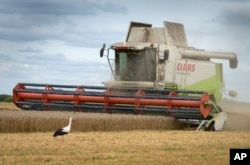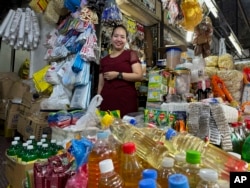Important foods like grains and cooking oil again are growing more costly in many places around the world.
Observers say that is because countries have put export restrictions in place to protect food supplies at home. They also blame the price rise on weather conditions and the Ukraine war.
Caroline Kyalo is a 28-year-old who works at a hair salon in Kenya’s capital Nairobi. She experienced the rising cost of food while planning meals for her two children. The price of onions has risen by 200 percent since neighboring Tanzania restricted agricultural exports. Kyalo tried a different kind of onion but those became too costly as well. Cooking oil and corn flour prices are increasing also.
So, she said, “I just decided to be cooking once a day.”
East Africa has fertile land and a large workforce. But the high cost of growing and transporting crops and a lack of rain have resulted in decreased local production. In the case of onions, the U.N. Food and Agriculture Organization found that, in 2014, Kenya was getting half of its onions from Tanzania. Some traders have tried to get supplies from Ethiopia. Others have stopped selling onions altogether.
But Timothy Kinyua, who says prices have reached their highest level in seven years, promised he would sell the crop.
“It’s something we can’t cook without,” he said.
Spreading food restrictions
Joseph Glauber is with the International Food Policy Research Institute in Washington. He said Tanzania’s onion limits this year are one example of the spread of food restrictions. He called it a “contagion,” or something that spreads like an infectious disease. His organization says that 19 countries have put 41 food export restrictions in place. The restrictions include bans or taxes.
India banned the export of some rice earlier this year cutting one fifth of the world’s export market. Myanmar answered with its own export bans. India has also restricted onion exports. The action sent prices climbing in Bangladesh.
Dry weather in Spain has hurt its olive crop causing European buyers to look to Turkey. But rising prices there led to export limits.
Morocco, which suffered a deadly earthquake recently, has also stopped exports of crops including onions, potatoes and tomatoes.
‘The new normal’
Over a period of years, food prices change sharply. In 2007 and 2008, rice and wheat prices doubled. Glauber, who also is a former economist from the Department of Agriculture, said changes are likely to continue.
“I think increased volatility is certainly the new normal,” he said.
For example, both Russia and Ukraine are major suppliers of wheat, barely, sunflower oil and several other foods important to developing nations. The conflict between them interferes with production by both.
Changes in weather are also affecting agriculture, observers say. El Niño is a periodic warm current in the southern Pacific Ocean. It is linked to changes in weather in several places around the world. Some scientists say climate change could make the El Niño current more severe affecting weather everywhere.
For example, a lack of rain in India means export restrictions there might not end with the new rice harvest in October.
Importers face added risk
Most at risk from weather changes are nations that depend heavily on imported food. The World Banks, for example, notes that the Philippines imports 14 percent of its food. However, recent storms could mean further crop deficits. Rice prices there increased 8.7 percent in August. That is double the increase from the month before.
Since prices increased, Philippine food store owners say they are losing money. Thirty-two-year-old Charina Em owns a store in the Trabajo market in Manila.
“We cannot save money anymore. It is like we just work so that we can have food daily,” she said.
Cynthia Esguerra is 66 years old and has several diseases. She said she has had to choose between medicines and food.
“I just don’t worry about my sickness. I leave it up to God. I don’t buy medicines anymore, I just put it there to buy food, or loans,” she said.
I’m Mario Ritter, Jr.
Aniruddha Ghosal, Evelyne Musambi and Jeoal Calupitan reported this story for the Associated Press. Mario Ritter, Jr. adapted it for VOA Learning English.
________________________________________________
Words in This Story
salon –n. a business that cuts hair and offers beauty treatments
volatility –n. the condition of changing sharply or unpredictably













Forum